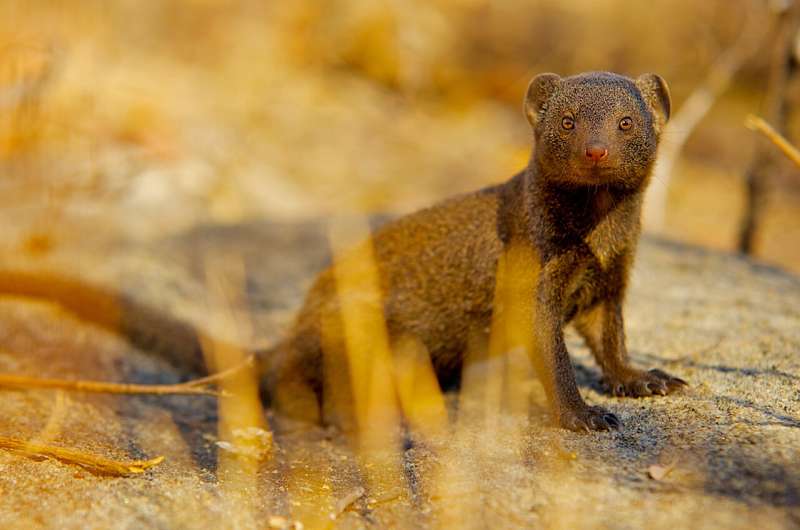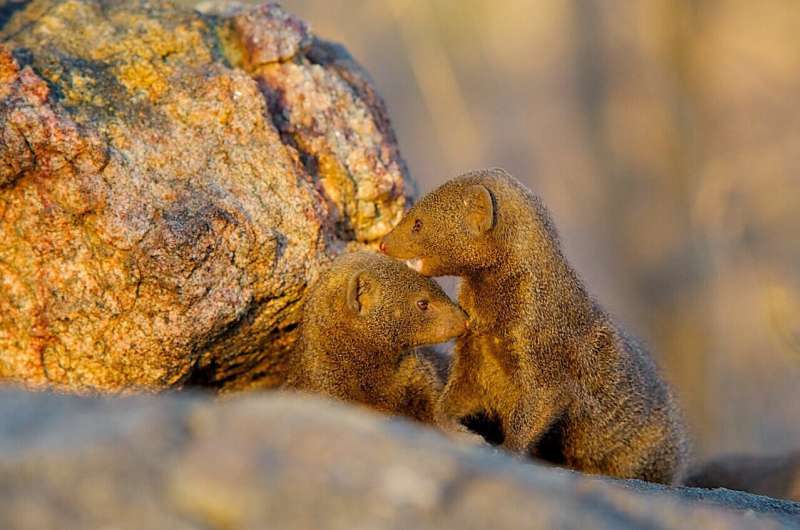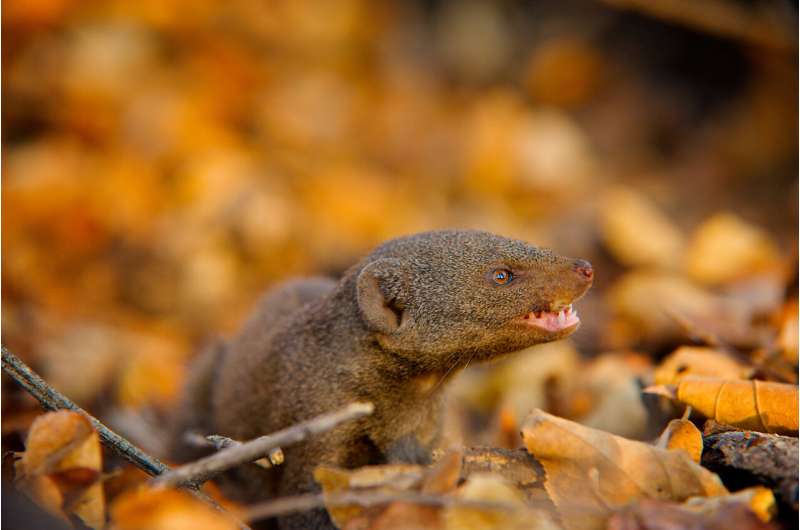https://www.ecotraining.co.za/the-littl ... in-africa/
The littlest carnivore in Africa
If you were ever asked to give some examples of African carnivores, what animals come to mind? Animals like lions, cheetahs, leopards, wild dogs and hyenas were some of the first animals you thought of. But did you know that there are other, much smaller carnivores out there as well?
Can you guess what the smallest carnivore in Africa is?
They have a long slender body, weigh approximately 300g and are about 40cm long (a little bit longer than a ruler). The length of their tail is almost the size of their body. They are normally dark brown, have large pointed heads and small ears.
It can be none other than the Dwarf Mongoose.
12 interesting facts about the Dwarf Mongoose you probably did not know:
Dwarf mongooses have a mutualistic relationship with red-billed and yellow-billed hornbills. They will often forage for insects together and warn each other if they see anything that might endanger them.
They live in groups that have between 8-30 members.
The plural of mongoose is mongooses – not mongeese
Their front feet have long, curved claws that are perfectly designed for digging when they go foraging for food. They eat snails, termites, grasshoppers, beetles, scorpions, centipedes, reptiles and eggs.
They have incredible senses. They detect their prey through using sound and smell. Their vision is perfectly adapted for spotting aerial predators as they have horizontal elongated pupils that give them an enlarged visual field.
Within each group there is strict hierarchy with the Alpha pair dominating the group. This Alpha couple will mate for life, with the Alpha female leading the group.
Generally only the Alpha pair will breed. Sometimes a subordinate female will breed and have offspring. However, the survival rate of these offspring is very low as the alpha female will often kill these babies to give her offspring the best chance of survival. This is known as infanticide.
The Dwarg Mongoose’s Shangaan name is machiki-chorr.
Enemies of a Dwarf Mongoose include birds of prey, snakes and jackals (who see them as a tasty snack). Because of this, the alpha male is always on the lookout for danger.
Fork-tailed Drongos can sometimes be seen hanging around the Dwarf Mongooses. They like to wait for the Dwarf Mongoose to find a tasty snack and when the moment is right they will mimic an alarm call to steal the Dwarf Mongooses food. Why? Well they have figured out that animals like the dwarf mongoose won’t ignore alarm calls, even if that means that they will lose a tasty meal. Sneaky! This is called kleptoparasites.
They are nomadic, curious creatures that are a lot of fun to watch on a game drive. They are diurnal (day time animals). They move form den to den in search of food. They like to sleep in old termite mounds but are equally at home in hollowed out trees or piles of stones.
Rough-scaled plated lizards also like to live with Dwarf Mongooses in termite mounds. Why? Because the lizards like to feed on the mongoose faecal matter.
So, next time someone asks you about carnivores in Africa don’t forget to mention the littlest one.
Dwarf Mongoose
-
Klipspringer
- Global Moderator
- Posts: 5862
- Joined: Sat Sep 14, 2013 12:34 pm
- Country: Germany
- Contact:
- Alf
- Posts: 11606
- Joined: Wed Nov 26, 2014 12:40 pm
- Country: south africa
- Location: centurion
- Contact:
Re: Dwarf Mongoose
They are so cute...
Alfie wants one
Alfie wants one
Next trip to the bush??
Let me think......................
Let me think......................
- Lisbeth
- Site Admin
- Posts: 67388
- Joined: Sat May 19, 2012 12:31 pm
- Country: Switzerland
- Location: Lugano
- Contact:
Re: Dwarf Mongoose
During my last Kruger visit, I only saw one, speeding across the road.
Maybe it would be a good idea to stop from time to time at a termite mound and wait.....
Maybe it would be a good idea to stop from time to time at a termite mound and wait.....
"Education is the most powerful weapon which you can use to change the world." Nelson Mandela
The desire for equality must never exceed the demands of knowledge
The desire for equality must never exceed the demands of knowledge
- Richprins
- Committee Member
- Posts: 75964
- Joined: Sat May 19, 2012 3:52 pm
- Location: NELSPRUIT
- Contact:
Re: Dwarf Mongoose
Kleptoparasites! I know some human ones! 
Yes, Lis. They are insanely curious and if you stop the car next to where they disappeared there is a great likelihood of them reappearing.
Yes, Lis. They are insanely curious and if you stop the car next to where they disappeared there is a great likelihood of them reappearing.
Please check Needs Attention pre-booking: https://africawild-forum.com/viewtopic.php?f=322&t=596
- Lisbeth
- Site Admin
- Posts: 67388
- Joined: Sat May 19, 2012 12:31 pm
- Country: Switzerland
- Location: Lugano
- Contact:
Re: Dwarf Mongoose
"Education is the most powerful weapon which you can use to change the world." Nelson Mandela
The desire for equality must never exceed the demands of knowledge
The desire for equality must never exceed the demands of knowledge
- Lisbeth
- Site Admin
- Posts: 67388
- Joined: Sat May 19, 2012 12:31 pm
- Country: Switzerland
- Location: Lugano
- Contact:
Re: Dwarf Mongoose
Mongooses give bullies the cold shoulder, scientists find

A dwarf mongoose. Credit: Shannon Wild
NOVEMBER 2, 2021 | By University of Bristol
Management of within-group conflict is a key feature of human lives and those of many social animals, with contestants known to adopt various strategies in the immediate aftermath to minimize costs. The study, published today in the journal eLife by a team at University of Bristol, shows that individuals not involved in the altercations can both track the aggressive behavior of others and act on that information at a later time.
Lead author Dr. Amy Morris-Drake, from Bristol's School of Biological Sciences, said: "Conflict management strategies have evolved to keep the peace in species as varied as chimpanzees, ravens and domestic dogs. Our work demonstrates that dwarf mongooses have sufficient cognitive ability to monitor vocal cues about aggressive interactions and to remember who the bullies are, refusing to groom with them later."
By working with wild groups of mongooses habituated to their close presence, the research team could collect detailed observations and test their ideas experimentally in natural conditions.
Co-author Dr. Julie Kern, now based at the University of New England, Australia said: "The crucial experiment entailed simulating the occurrence of food contests between two group members during the afternoon, through playback of the vocalizations given by aggressors and victims. The rest of the group therefore heard what sounded like repeated squabbles involving these individuals."
Senior author Prof. Andy Radford, also from Bristol, added: "On experimental days, we recorded all the grooming that individuals engaged in with their groupmates back at the sleeping burrow that evening. Being groomed helps with hygiene and reduces anxiety, and grooming underpins social relationships, so is core to social life."

Two mongooses grooming. Credit: Shannon Wild
On evenings that followed the simulation of increased within-group conflict, subordinate mongoose group members groomed with one another more than on control evenings. Most strikingly, the subordinates also ignored the perceived aggressors, who received substantially less grooming than on other occasions.
Dr. Morris-Drake said: "This shows that dwarf mongooses keep tabs on conflict occurring between their groupmates. They can identify bullies just from the vocalizations given during disputes, store this information and implement a delayed conflict-management strategy, in this case giving the bully the cold shoulder before bedtime."
The findings are important because it is often suggested that it is difficult for animals to remember past altercations between groupmates, only to act on them later, particularly when the individual was not involved in the interaction and with everyday life continuing in the interim.

A dwarf mongoose engaged in an aggressive interaction over food. Credit: Shannon Wild
Dwarf mongooses are Africa's smallest carnivore, living in cooperatively breeding groups of 5–30 individuals. The work was conducted as part of the Dwarf Mongoose Research Project which has studied habituated wild groups continuously since 2011. The study animals are individually marked with blonde hair dye, are trained to climb onto a balance scale to weigh themselves, and can be watched from a few feet away as they go about their natural behavior in ecologically valid conditions.

A dwarf mongoose. Credit: Shannon Wild
NOVEMBER 2, 2021 | By University of Bristol
Management of within-group conflict is a key feature of human lives and those of many social animals, with contestants known to adopt various strategies in the immediate aftermath to minimize costs. The study, published today in the journal eLife by a team at University of Bristol, shows that individuals not involved in the altercations can both track the aggressive behavior of others and act on that information at a later time.
Lead author Dr. Amy Morris-Drake, from Bristol's School of Biological Sciences, said: "Conflict management strategies have evolved to keep the peace in species as varied as chimpanzees, ravens and domestic dogs. Our work demonstrates that dwarf mongooses have sufficient cognitive ability to monitor vocal cues about aggressive interactions and to remember who the bullies are, refusing to groom with them later."
By working with wild groups of mongooses habituated to their close presence, the research team could collect detailed observations and test their ideas experimentally in natural conditions.
Co-author Dr. Julie Kern, now based at the University of New England, Australia said: "The crucial experiment entailed simulating the occurrence of food contests between two group members during the afternoon, through playback of the vocalizations given by aggressors and victims. The rest of the group therefore heard what sounded like repeated squabbles involving these individuals."
Senior author Prof. Andy Radford, also from Bristol, added: "On experimental days, we recorded all the grooming that individuals engaged in with their groupmates back at the sleeping burrow that evening. Being groomed helps with hygiene and reduces anxiety, and grooming underpins social relationships, so is core to social life."

Two mongooses grooming. Credit: Shannon Wild
On evenings that followed the simulation of increased within-group conflict, subordinate mongoose group members groomed with one another more than on control evenings. Most strikingly, the subordinates also ignored the perceived aggressors, who received substantially less grooming than on other occasions.
Dr. Morris-Drake said: "This shows that dwarf mongooses keep tabs on conflict occurring between their groupmates. They can identify bullies just from the vocalizations given during disputes, store this information and implement a delayed conflict-management strategy, in this case giving the bully the cold shoulder before bedtime."
The findings are important because it is often suggested that it is difficult for animals to remember past altercations between groupmates, only to act on them later, particularly when the individual was not involved in the interaction and with everyday life continuing in the interim.

A dwarf mongoose engaged in an aggressive interaction over food. Credit: Shannon Wild
Dwarf mongooses are Africa's smallest carnivore, living in cooperatively breeding groups of 5–30 individuals. The work was conducted as part of the Dwarf Mongoose Research Project which has studied habituated wild groups continuously since 2011. The study animals are individually marked with blonde hair dye, are trained to climb onto a balance scale to weigh themselves, and can be watched from a few feet away as they go about their natural behavior in ecologically valid conditions.
"Education is the most powerful weapon which you can use to change the world." Nelson Mandela
The desire for equality must never exceed the demands of knowledge
The desire for equality must never exceed the demands of knowledge
- Richprins
- Committee Member
- Posts: 75964
- Joined: Sat May 19, 2012 3:52 pm
- Location: NELSPRUIT
- Contact:
Re: Dwarf Mongoose
Interesting!
Please check Needs Attention pre-booking: https://africawild-forum.com/viewtopic.php?f=322&t=596
- Lisbeth
- Site Admin
- Posts: 67388
- Joined: Sat May 19, 2012 12:31 pm
- Country: Switzerland
- Location: Lugano
- Contact:
Re: Dwarf Mongoose
In our second story, we honour one of Africa’s most ferocious and courageous fighters: the dwarf mongoose. With razor-sharp claws and sharp teeth juxtaposed with an otherwise adorable fluffy exterior, the dwarf mongoose is Africa’s smallest mammalian predator. Read more to see what we love about these enigmatic little creatures.

DWARF MONGOOSE
The dwarf mongoose is Africa's smallest mammalian predator & are fascinating to see on safari
Read more here
There are also lots of great photos!

DWARF MONGOOSE
The dwarf mongoose is Africa's smallest mammalian predator & are fascinating to see on safari
Read more here
There are also lots of great photos!
"Education is the most powerful weapon which you can use to change the world." Nelson Mandela
The desire for equality must never exceed the demands of knowledge
The desire for equality must never exceed the demands of knowledge


